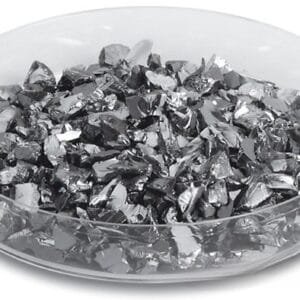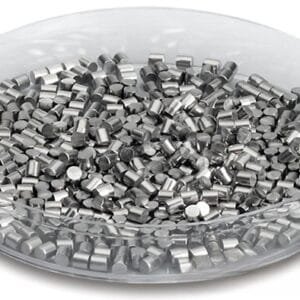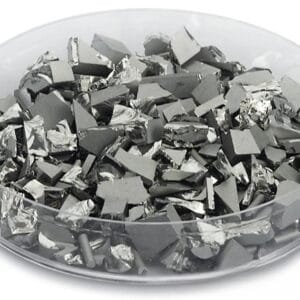Manganese Evaporation Material Description
Manganese is a gray-white, hard, brittle, and shiny transition metal. Pure manganese is slightly softer than iron, while manganese with minor impurities is firm and brittle. This element is widely found in nature, with soil containing approximately 0.25% manganese, and higher concentrations found in tea, wheat, and hard-shelled fruits.
High-purity manganese evaporation materials play a crucial role in deposition processes, ensuring the production of high-quality deposited films. TFM specializes in producing manganese evaporation materials with purity levels of up to 99.95%, employing quality assurance processes to guarantee product reliability.

Manganese Evaporation Material Specification
| Material Type | Manganese |
| Symbol | Mn |
| Color/Appearance | Metallic Solid |
| Melting Point | 1024°C |
| Density | 6800 kg/m3 |
| Thermal Conductivity | 0.165 W/cm/K @ 25 °C |
| Electrical Resistivity | 64.0 microhm-cm @ 25°C |
| Synonyms | Mn Pellets, Mn Pieces, Mn Evaporation Pellet, Manganese Pellets, Manganese Pieces, Manganese Evaporation Pellet |
Manganese Evaporation Material Applications
Manganese evaporation materials are pivotal in various advanced applications, including:
- Deposition Processes: Utilized in semiconductor deposition, chemical vapor deposition (CVD), and physical vapor deposition (PVD) to create high-quality, uniform films.
- Optics: Employed in the production of optical coatings, wear-resistant layers, and decorative finishes to enhance performance and durability.
Manganese Evaporation Material Packaging
We carefully manage the handling of our manganese evaporation materials to avoid damage during storage and transportation. This meticulous approach ensures that the quality and integrity of our products are preserved in their original condition.
Get Contact
TFM offers manganese evaporation materials in a variety of forms, purities, sizes, and price ranges. We are experts in producing high-purity e-beam evaporation materials, characterized by optimal density and minimal average grain sizes. For current pricing on evaporation pellets and other deposition materials not listed, please send us an inquiry.
Ordering Table
| Material | Size | Quantity | Purity | Part Number |
| Manganese | 3mm - 12mm Pieces | 1 kg | 99.95% | EVMMNM1034 |
| Manganese | 3mm - 12mm Pieces | 50 g | 99.95% | EVMMNM1034B |
| Manganese | 3mm - 12mm Pieces | 200 g | 99.95% | EVMMNM1034H |
| Manganese | 3mm - 12mm Pieces | 500 g | 99.95% | EVMMNM1034T |

 MSDS File
MSDS File



Reviews
There are no reviews yet.